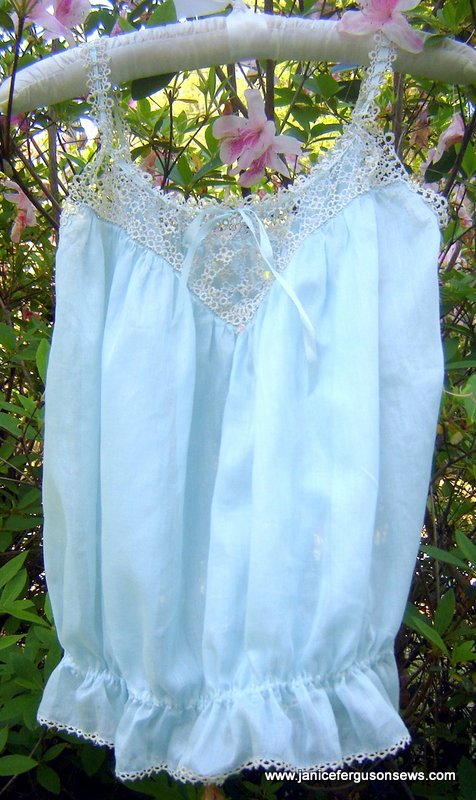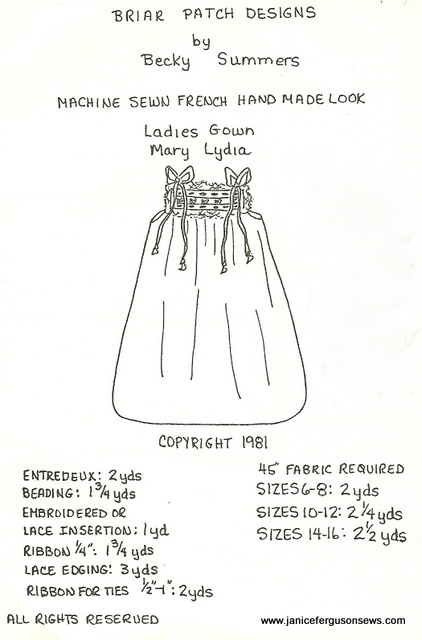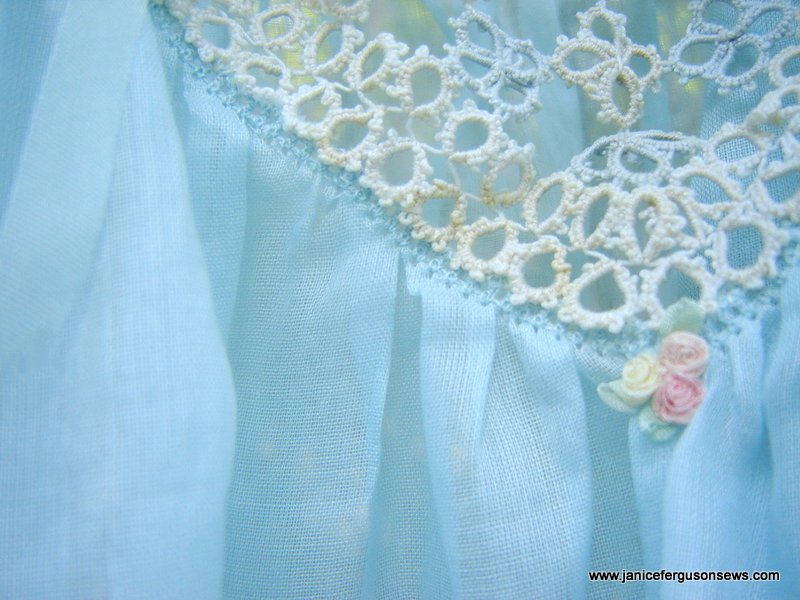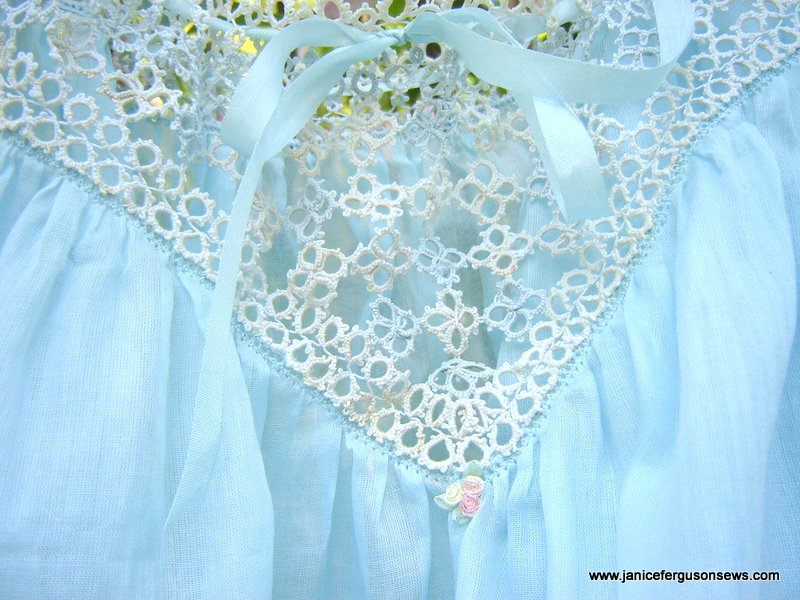BACKGROUND: The tatted yoke on this camisole is at least 90 years old. What a testimony to the sturdy fruit of the shuttle! I had sentimental reasons for my appreciation of this yoke (detailed below in HISTORY) and made a camisole for my daughter. Miss Alice, the previous owner, was especially fond of my children and they grew up knowing her as an exemplary model of Christian womanhood. In 1996, this garment was featured in my series entitled  Antique Textiles in Creative Needle magazine.
CONSTRUCTION TECHNIQUE: The project was a challenge. I needed a way to attach the yoke to the gathered fabric without detracting from the intricacy of the tatting pattern. Commercial entredeux just seemed too new and joining it to the gathered fabric would be bulkier than desired. Also, white entredeux was too bright and ecru was too dark. Machine made entredeux was the perfect solution but just how to do that on a diagonal line across the gathered straight of grain fabric made me ponder long and hard.
Whether or not this was the best way, it was the only way I could conjur up. First, the yoke was heavily starched and pressed. Tatting thread is dense and takes time to absorb the starch completely.  Then it takes a good bit of time to dry. I pinned the yoke to my gridded cardboard cutting board, which is covered with clear plastic. The grid allows the piece to be pinned symmetrically and dry properly shaped.
AÂ favorite nightgown pattern, Lydia, by Becky Summers, was used for basic measurements and the armhole curve.
While the tatting was drying,  rows of gathering threads were stitched every 1/2″ on a block of finella, the ultra sheer batiste.   The block was the desired length of the finished camisole plus 5″ for margin or error. The width of the block was twice the width of the yoke, plus several inches to allow for the armhole curves.
A day later, when the yoke was dry, it was pressed, placing all the little loops and extensions in place.  With the yoke stiff and flat, the bottom lines of the V shape were traced onto paper. That was cut out and placed over the gathered batiste. I traced the V shape with water soluble marker onto the batiste and then with a wing needle, stitched entredeux along the line. The gathered fabric inside the V was cut away, close to the entredeux stitching line.
The fear of cutting the aged tatting with a machine needle led me to conclude that handsewing the two pieces together was the wiser choice. So as taught in French handsewing classes, I hand basted the entredeux edged batiste and the tatted yoke to paper (blank newsprint),  with the edges butted snugly one against the other. The two pieces were hand whipped together.
Vintage tatting from the same source as the yoke was joined to the hemline. A casing was made for elastic and silk ribbon was threaded through the beading in the yoke. The finella had been chosen specifically because it matched both the blue flowerettes in the tatting and the wide silk ribbon in my stash.  The finishing touch was a cluster of three silk ribbon rosebuds at center front.
HISTORY: I love tatting. To the best of my knowledge, as late as 1985, it was not available commercially. Now it is made in great quantities in China, is reasonably priced and readily available, but only in yardage in a limited number of patterns.
Before that, it was made on front porch swings in the deep South by mothers while children took afternoon naps, by grandmothers rocking to the warmth of a winter fire, by aunties taking a rest from the day’s chores. Old tatting, therefore, always has a history. Some is known, passed down through family recollections.   Some is not.
In the earlier post about the Day grandchildren’s Easter garments, I mentioned that the tatting on the bishop dresses was made by their great, great grandmother.  She never could have known that four generations later it would be the finishing touch on Easter finery.
Fortunately, I know at least part of the history of the beautiful tatted yoke on this camisole. But in order to tell the story, I have to go back some distance in time.
Just after the Civil War, our little community was settled, mostly by families from the northeast who came to plant citrus and pineapples. In 1884, the Glenwood Community church was established and shortly thereafter served as the schoolhouse and center of all local activity.  The young Van Cleef family with their four children were in the midst of these events. Alice, the youngest, was born in 1906 in the large, 2 story family home. Her mother, Nina, was an accomplished needleworker and tatted this yoke.
A few years before Alice’s birth, a poor young girl began working for the family, helping in the kitchen and with the children. When she was 13 years old,  Mathilda was asked to launder all the baby clothes, which puzzled her as there were no babies in the family. One morning a week later, she came to work and met baby Alice, born in the night.
Mathilda was a working fixture in the home as Alice grew up. Even after Mathilda married and had a home of her own, she took in laundry and always did Alice’s wash. She liked to say that she had been doing Alice’s laundry since before she was born.
When I bought this yoke, it was attached to worn fabric which had been badly mended. In Alice’s hand, her name was inscribed in black Sharpie pen along the hemline, apparently to help Mathilda keep track of Alice’s clothes.
Alice was a rough and tumble girl, then a high school science teacher.   Miss Alice, as she was called by anyone more than 10 years her junior,  had been proclaimed Unofficial Mayor of our little community.   In an effort to reduce expenses to free up funds for mission work, our church posted a list of chores for which members could sign up. No one volunteered to clean out the gutters.
One day, 81 year old Miss Alice was discovered up on the roof doing just that.  Our  young pastor gasped and scrambled up the ladder to help her down. But she tried to shoo him away, saying she was not yet done! She then admonished him to get back to sermon preparations. He helped finish the gutters and assisted agile Alice, unnecessarily, down the ladder.  That was the last time roof work was put on the volunteer chore list, but shamed younger members who saw to it that the gutters were always clean.
Miss Alice called on every new family in town, invited them to church, carried meals to the sick, visited shut ins, drove neighbors to doctor appointments, served as a Pink Lady at the hospital, taught Sunday School for most of her life and in general lived the life of a saint, which is the level of regard in which she was held by all.  Unmarried, she lived in the Van Cleef family home until she died at 94,  loved and mourned by all. But Alice could not sew. Or embroider. Or knit.  Or tatt. But she was extraordinary in every other field.
She saved everything related to family, including her parents wedding clothes and all other garments with historical merit. When she died, the family donated most of these items to the church to be sold. Among a variety of  items, this yoke was one of my purchases. Others showed further evidence of  Alice’s clumsy attempts at garment repair as well as her lack of interest in any form of needlework, except for saving it.
I thought of Nina Van Cleef as I examined this camisole yet again and photographed it. Just like Judy Day’s grandmother, Nina could not have known that her tatted yoke would appear in a magazine and be in use almost 100 years later. And as I so often do, I think of dear Miss Alice. I believe her legacy of service and Christian witness will live on in the lives of all she touched.







3 responses to “Alice Camisole”